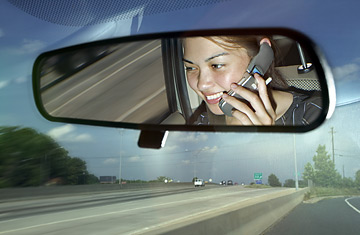
At any given time, as many as one in 10 drivers are talking on their cell phones behind the wheel, say researchers at the University of Utah Traffic Lab. These distracted drivers not only pose a safety hazard, but, as new data suggests, they may be slowing down your commute.
Drivers on cell phones, even on hands-free devices, travel more slowly than other drivers, are less likely to pass sluggish vehicles and ultimately take longer to complete their commute — researchers estimate that such distracted drivers lengthen the average car commute by about 5% to 10%. That amounts to only a few extra minutes a day, but those minutes add up. Say your hour-long commute were cut by 10% a day — or 6 mins. — in each direction; the savings would translate to an entire weekend of free time a year. An additional 30 to 50 hours of yearly commuting time per person costs society broadly too — in fuel consumption, poorer air quality, and lost productivity at work. "When you take all the delays and aggregate them on a national level it is a staggering cost," says Peter Martin, associate professor of civil and environmental engineering and director of the University of Utah Traffic Lab.
In the new study, researchers tested 36 volunteers in driving simulators that reflected traffic speeds and conditions on Interstate 15, a major thoroughfare through Salt Lake City. Participants were observed "driving" in medium- and high-density traffic, and were told to obey the 65 mph speed limit and use turn signals; some were allowed to talk on their hands-free phones. The study was designed so that traffic would periodically slow in one lane, while another lane opened up. Researchers found that cell-phone users switched to faster-moving lanes about 20% less frequently than other drivers. They were less adept at keeping up with traffic flow, and it took them 2% to 3% longer to complete the commute than drivers who weren't distracted by cell phones.
Driving while talking into a cell phone is sort of like driving with one eye closed — studies suggest that your brain processes only half of the visual information it receives. So obstacles like pedestrians and swerving cars may go unregistered by the distracted driver. The effect is the same whether you use a handset or a hands-free phone, but, interestingly, listening to the radio or engaging in conversation with a fellow passenger isn't nearly as distracting. "There is something about talking on the phone that trips up the brain," says David Strayer, the study's author and a professor of psychology at the University of Utah, whose previous research found that drivers on cell phones were slower to react and five times more likely to have an accident than other motorists. "We are learning that there is something important about the production of speech and the role linguistics play in multitasking."
One theory is that when we're talking, we are busy generating mental images that may interfere with spatial codes necessary for driving. Another theory holds that we're overtapping our brain capacity by attempting two challenging tasks — having a conversation and driving a car — simultaneously. "The requirements to both listen carefully and respond while on a cell phone creates 'interference' with the task at hand, driving in this case, and our research shows that we have limited cognitive resources to multitask," says Arthur Kramer, director of the Biomedical Imaging Center at the University of Illinois. When demand for our "neural resources" exceeds supply, the result is decreased performance — scanning less attentively for pedestrians, for example, or failing to maintain a lane or speed.
In a separate series of studies using simulators Strayer and his colleagues asked participants to navigate various traffic conditions while talking on a cell phone, then again while talking to the same person, this time in the simulator. The cell-phone talkers were far more distracted than drivers who talked to a passenger: 50% of the drivers on cell phones missed a designated exit, while none of those talking to a passenger did. "You communicate differently when you are in the car with someone because both people are aware of and can adjust to conditions that might require more concentration," Strayer says. The passenger may point out an upcoming exit, help navigate, alert you to a sudden stop, or understand when bad weather requires quiet concentration.
People have always multitasked behind the wheel: They smoke, brush their teeth, put on makeup, yell at the kids in the back seat. But the recent explosion in wireless technology has introduced a host of new and more complicated driver's side activities, like programming navigation systems, text messaging (which is even more dangerous than talking on the phone) and using laptops. "The distractions now are more cognitively demanding," says Strayer. "Now instead of short manual tasks like lighting a cigarette or changing the radio station, they have become mind-occupied tasks that take longer, placing a greater demand on the mind and compete for our attention."
